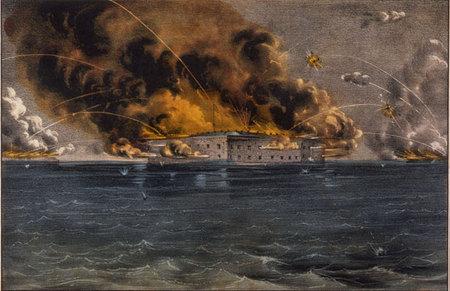The first shots of the Civil War were fired at Fort Sumter on April 12, 1861. One hundred and fifty years later, Fort Sumter National Monument preserves and interprets the site.
797,713
Recreational visits in 2010 (up 1.5% from 2009). The Civil War 150th anniversary celebration should produce an attendance spike. The existing attendance record, which stands at nearly 923,000 visits, was set in 2002.
70,000
Tons of New England granite, shipped from as far away as Maine, used to prepare the 109,000-ton rock foundation on which Fort Sumter was built. The fort was constructed (starting in 1829) on what was essentially a large sandbar near the Charleston harbor entrance.
47,000+
Projectiles fired at Fort Sumter. Confederate forces fired more than 3,000 artillery and mortar shells at the fort during the 34-hour bombardment in April 1861. The lengthy Union siege of the Confederate-held fort that began on April 7, 1863, yielded another 44,000 projectiles, or about seven million pounds of ordnance. Despite this pounding, which reduced the two upper gun tiers to rubble, the fort's defenses were never breached.
1,407
Days during the Civil War when the flag of the United States of America did not fly over Fort Sumter. The Union flag was lowered in surrender on April 13, 1861, and Confederate troops occupied the fort the next day. Federal troops raised another Union flag over the fort on February 18, 1865, one day after the Confederates abandoned it. (The much-ballyhooed re-raising of the fort's original 1861 "surrender flag" didn't take place until April 14, 1865, the anniversary of the fort's surrender.)
385
Maximum number of visitors allowed at the Fort Sumter site at any given time. According to the Superintendent's Compendium, this carrying capacity restriction is needed to protect historic resources, insure personal safety, and prevent undue impairment of visitor enjoyment.
250?
Civil War reenactors who will be encamped at the park's Fort Moultrie unit during the 150th anniversary commemoration of the Battle of Fort Sumter. Union reenactors will be on site April 9-13, flag ceremonies will take place at the fort on April 14, and Confederate re-enactors will occupy the fort during April 15–17.
200
Acreage of the park, which consists of three units -- Fort Sumter in Charleston harbor, the Fort Sumter Visitor Education Center at Liberty Square in Charleston, and Fort Moultrie on Sullivan's Island . The latter is the scene of the patriot victory of June 28, 1776, one of the earliest defeats of the British in the American Revolution.
87
Union officers and enlisted men defending Fort Sumter. Because Confederates had stymied resupply efforts, this undersized garrison (a fraction of the 650 men the fort was built to accommodate) was nearly out of food when the bombardment began and quickly ran so low on cartridges bags that they could only fire a few guns at a time.
54+
Men killed at Fort Sumter during the Civil War. (In addition, at least 267 were wounded.) The Confederate's 34-hour bombardment produced no fatalities. However, two Union soldiers died as the result of a surrender ceremony accident (a cannon discharged prematurely during a salute to the U.S. flag) and 52 of the fort's Confederate defenders were killed during the Union siege that began in 1863. An unknown number of slave workers were also killed in the fort.
50 feet
Height of the fort's brick masonry walls, above low tide, when the Civil War began. The five-sided Third System fort, which was only 90% completed, was designed with three tiers of gun emplacements.
ca. 30 minutes
Length of the concessioner-operated ferry boat trip to Fort Sumter from the park's Visitor Education Center at Liberty Square. Ferry service is also available from the Patriot's Point Maritime Museum in Mount Pleasant across the harbor. During the summer there are three departures daily from each location.
7 or 8 feet
Depth of the salt water on the fort's parade ground after Hurricane Hugo struck Charleston in September 1989. The fort's dock had to be replaced, but there was surprisingly little other storm damage.
3
Projectiles imbedded in the fort's masonry. Many of the projectiles that struck the fort's interior walls and casements were solid (non-explosive) projectiles designed to deeply penetrate and shatter brick masonry. These three were left in place where they can be readily seen by visitors.
1
Indian chief buried in a marked grave at the park. The great Seminole chief Osceola was imprisoned at Fort Moultrie and died there of scarlet fever on January 30, 1838. His grave marker, which reads "Osceola, Warrior and Patriot," is located at Fort Moultrie's visitor entrance.
0
Troops garrisoning Fort Sumter during 1876 -1897 when the island primarily served as a lighthouse station. In 1898 the Army constructed Battery Huger (yu-GEE) in the fort to bolster Charleston's harbor defenses. This reinforced concrete battery, which was manned during World War I and World War II, still visually dominates the fort’s interior.




Add comment